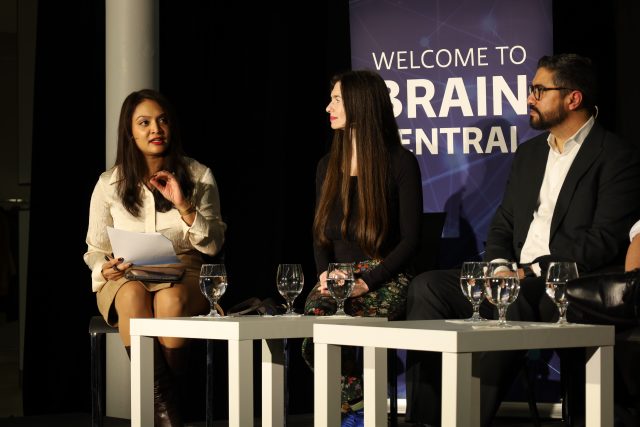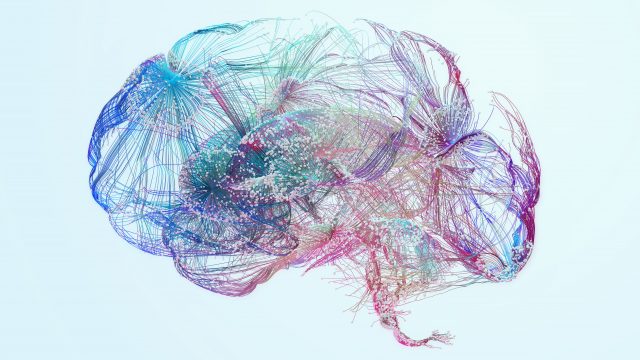The wealth of information available in the modern world has given rise to the idea of ‘Big Data’. Massive amounts of data hold the potential to provide us with major insights. However, for this to be possible, data must be collected, analysed, and linked in the right way. When harnessed effectively, ‘Big Data’ may soon be able to give us big insight into what’s most relevant to an individual’s care.
Ontario contains a vast array of information on brain health care, from basic neuroscience to patient data. In order to maximize the value of brain science data in Ontario, OBI has created its own Big Data initiative, called Brain Centre for Ontario Data Exploration (Brain-CODE).
Brain-CODE streamlines the acquisition, storage and analysis of information from research into brain disorders covering a range of scientific disciplines. The scope of brain disorders addressed by Brain-CODE corresponds to OBI’s Integrated Discovery (ID) programs: cerebral palsy, epilepsy, depression, neurodevelopmental disorders such as autism and intellectual disability, and neurodegenerative disorders such as Parkinson’s and Alzheimer’s disease. Information related to each of these disorders is captured in a variety of ways, including neuroimaging, clinical, behavioural, genomic, and proteomics (the study of proteins). The result is an immense amount of centralized information, the likes of which has never been seen before.
Ultimately, Brain-CODE will give researchers and clinicians a unique toolbox to store, compare, and analyze research data, paving the way for new advances at the frontier of patient care and brain health. If you are new to Brain-CODE, here is a primer on how it works, and why it is exciting:
1. It will give researchers new perspectives, enabling new questions
“This is the first time anywhere this mass of data is all being brought together under one roof, in a common database where we can ask questions about how this information interrelates. Furthermore, when you factor in the ability to link it to population health data, it becomes an incredibly powerful tool,” says Dr. Mike Strong, Principal Investigator of OBI’s Ontario Neurodegenerative Disease Research Initiative (ONDRI) ID program.
| • Neuroimaging – data from technologies that allow us to take pictures of people’s brains, each in different ways, such as MRI (magnetic resonance imaging), PET (positron emission tomography), EEG (electroencephalography), and others.
• Genomics/Proteomics – data on the genes and how the environment affects these genes (epigenetics). Proteomics is information related to protein growth associated with brain disorders. • Clinical/behavioural – data from physical examinations, illness and treatment histories, plus psychological, cognitive, and behavioural assessments related to the disorder. • Demographic – data regarding age, gender, ethnicity, social and physical environment, etc. |
All the possibilities opened up by Brain-CODE are almost hard to imagine. “A tool like this will help us make connections we didn’t even know existed. It will allow us to begin looking across disorders and brain conditions to better understand common underlying causes,” says Dr. Evdokia Anagnostou, a clinician-scientist leading OBI’s Province of Ontario Neurodevelopmental Disorder Network (POND) ID program. A tool like Brain-CODE is tremendously powerful as it will allow researchers to individually examine each puzzle piece of a brain disorder.
Brain-CODE will allow researchers to use findings from basic science to drive clinical impact—this is important for new discoveries. A current project underway in the POND ID program is linking the genetic mutations associated with autism spectrum disorders to changes in brain structure, and ultimately to the behaviours seen in children with the disorder. “It’s very important for us to be able to understand the biological roots of these disorders in order to develop effective treatments,” explains Dr. Anagnostou. Essentially, Brain-CODE will allow researchers to identify the “fingerprints” of brain disorders, so they may be recognized, studied, and treated.
2. It will improve clinical trials
“The patient is the absolute focal point of the work,” says Dr. Sidney Kennedy, Principal Investigator of the Canadian Biomarker Integration Network in Depression (CAN-BIND) ID program, and Professor of Psychiatry at the University of Toronto. People affected by brain disorders need new discoveries and new treatments. But before pharmaceutical companies can market a product, such as a new drug, it has to go through a long series of clinical trials to determine its safety and effectiveness, and even then, treatments may be helpful only for a sub-group of individuals with a disorder. There are clear limitations.
Brain-CODE will help to overcome these hurdles by directly incorporating patients into the research process. The platform’s comprehensive records will allow patients to be placed in clinical trials more efficiently, simplifying and accelerating the process of finding and recruiting subjects to help move valuable treatments to the market more quickly. “Patients are very critical stakeholders, and it’s the job of researchers to help patients know what we can do now and what we hope to do… I think these are very important opportunities to help patients feel that research is important to them,” says Dr. Helen Mayberg, Professor of Psychiatry, Neurology, and Radiology at Emory University School of Medicine, who advises the CAN-BIND program.
Dr. Mayberg recognizes that Brain-CODE will open a new dialogue among those affected with brain disorders and those responsible for their care: “There is collaboration between patients and researchers – valuable information flows in both directions. We have an opportunity to discuss the process of research so patients don’t have misconceptions or fears and a lot of the times patients may have a unique perspectives that researchers may not see, and that’s very important”. Brain-CODE will allow researchers to work with patients to optimize brain health care.
3. It enhances the research potential of every institution in Ontario, individually and as a whole
Brain-CODE is entirely borne of OBI’s ID programs: each of the five programs is currently collecting a wide range of data related to more than 10 brain disorders across multiple disciplines – a wealth of information that is ripe for data-mining. Brain-CODE allows for all of these data to be collected, standardized, and compiled from across Ontario, amplifying the value of every data point as it becomes useful to researchers across the province. The result is that neuroscience and brain health care gains focus in Ontario. As Dr. Doug Munoz, a leading researcher in the field of neurodegenerative disorders and a member of OBI’s ONDRI program nicely explains: “My research lab is now not only at Queen’s University, it’s actually all of Ontario”.
4. It leads in the highest standards of privacy and security
There is little information more sensitive than that regarding someone’s genes, health, and brain – literally the essential details of one’s individuality. Brain-CODE will house these sorts of personal data for everyone involved in brain-related research in Ontario. Therefore, OBI has taken a proactive approach to security since the very beginning of Brain-CODE’s development. Dr. Ann Cavoukian, the Information and Privacy Commissioner of Ontario, and her staff began working with the OBI in 2012 to ensure that the highest privacy standard is embedded within the very core design of Brain-CODE – it’s called “Privacy by Design”.
Brain-CODE employs multiple privacy safeguards. One measure is that patients must provide informed consent, acknowledging how their data will be used. Before any kind of information enters Brain-CODE, health card numbers are encrypted for anonymity. Furthermore, prior to the release of any data, a powerful Privacy Risk Assessment Tool is used to prevent any data from being re-identified. OBI has also carried out Privacy Impact Assessments (PIA) and is initiating a Threat and Risk Assessment (TRA) to test the privacy and security of the system and policies in place. For its exemplary commitment to information protection, Brain-CODE was given ambassador Status for Privacy by Design by the Information Privacy Commissioner of Ontario in October, 2012, formally establishing this system as a leader in the area of privacy and security.
Brain-CODE is still under development to best serve the needs of patients, researchers, doctors, and treatment developers. The OBI vision for Brain-CODE is not only a ‘Big Data’ repository but also a common ground for analysis and discovery, a tool that will serve to connect different groups of researchers with the brain disorders they work toward improving. It will connect patients to better clinical trials, allow researchers to collaborate in unprecedented ways, and allow treatment developers to get their product to market faster. For all the promises of ‘big data’, Brain-CODE is set to usher in a new era of brain research and health in Ontario.
Back to Brainnovations Newsletter


